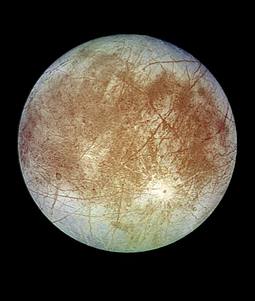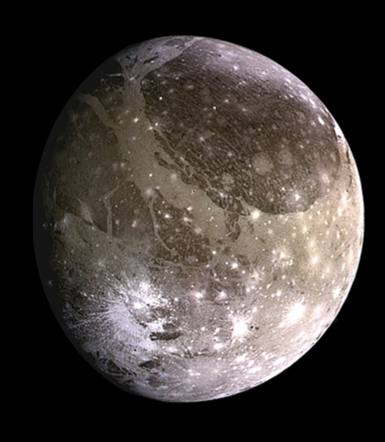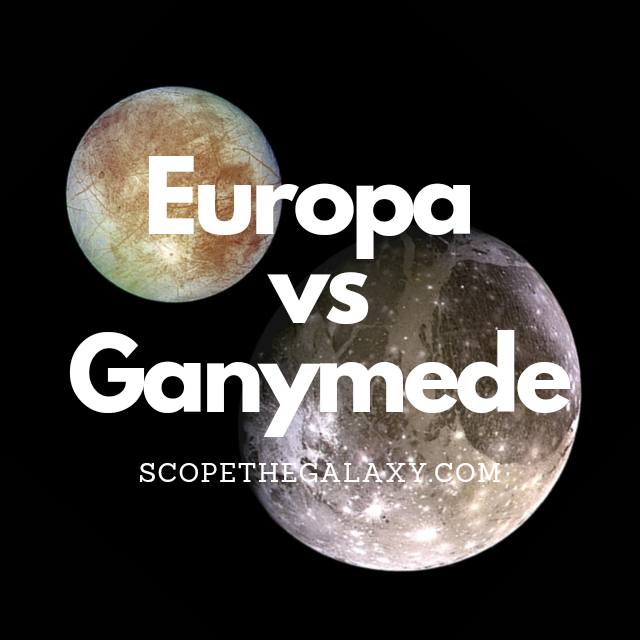*This post may contain affiliate links. This means we may make a commission if you purchase an item using one of our links*
Europa and Ganymede are two Galilean moons (alongside Io and Callisto) that were discovered by Italian astronomer Galileo Galilei in the 17th century. Both of these moons possess unique qualities that fascinate scientists and astronomers alike.
Discover the reasons why Europa and Ganymede are so interesting, which could be home to extraterrestrial life, plus the similarities and differences between the pair.
What Is The Moon Europa?
Table of Contents

Europa is the smallest of the Galilean moons, first discovered on 8th January 1610. The surface of this icy world is frozen, but scientists believe a watery ocean could lie beneath the surface. And in 2012, researchers found a possible water plume in the Southern polar region of Europa.
This research is yet to be confirmed; still, it gives us reasonable grounds to hypothesize that water could exist on this icy moon.
Estimates place Europa at around 4.5 billion years old (the same age as its planet, Jupiter), and its average distance from the Sun is approximately 780 million km.
It has a diameter of 3,121.6km, which makes it larger than pluto but smaller than the Earth’s moon, and the maximum temperature is a chilly minus 160 degrees Celsius.
Europa takes three-and-a-half days to orbit its planet at an average distance of 670,900km, and it is tidally locked, meaning the same side of the moon always faces Jupiter.
Among the fascinating features of this ice moon is its incredibly reflective nature. The icy crust of this body provides a light reflectivity of 0.64 – the highest of any moon in the solar system.
Data from the Galileo spacecraft suggests that Europa is composed of an iron core, rocky mantle, and silicate rock (a similar composition to Earth).
The moon’s surface is covered in cracks, which many theorize could result from tidal currents beneath the surface. It is this potential of water – and of life – that keeps astronomers so interested in this moon.
Europa might be small, but astronomers estimate it holds two to three times more water than the Earth. In addition, this moon possesses the essential elements for life, such as carbon, oxygen, hydrogen, and nitrogen.
There may be no solar energy on this moon, but hydrothermal vents could provide energy, and tidal heating from Jupiter could provide a heat source and keep the moon stable enough for life to form. In addition, the liquid ocean is well protected from radiation from thick, icy surfaces.
What Is The Moon Ganymede?

Ganymede is the largest of the Galilean moons – and the largest moon in our entire solar system – first discovered on 7th January 1610. The surface of this icy world is frozen and covered by two main types of landscape: young, light regions and old, crater-filled terrain. And these darker areas seem to contain a number of organic materials.
Using the Hubble Space Telescope, astronomers have found evidence of an oxygen-based atmosphere. Still, it is far too thin to support any living organisms that we know of. Based on this, it’s unlikely that Ganymede hosts life as we know it.
Estimates place Ganymede at around 4.5 billion years old (the same age as its planet, Jupiter), and its average distance from the Sun is approximately 778 million km.
Its diameter is 5,268km, making it larger than the planet Mercury. Despite this, Ganymede only possesses half the mass of Mercury, so it is still classified as a low-density object.
Ganymede takes seven days to orbit its planet at an average distance of 665,00km, and the temperature varies from minus 112 to minus 193 degrees Celsius.
Among the fascinating features of this ice moon is its magnetosphere. While many planets possess a magnetosphere, no other moon in our solar system shares this trait.
Measuring the changes in the magnetic fields of Ganymede and Jupiter allowed scientists to predict that salt water lies beneath the surface of this freezing world.
However, this is insufficient to support life when you factor in the other elements of this giant moon. In contrast to Europa, the rocky layer of Ganymede is not directly below the ocean, so life would have a difficult time forming both above and below the ice.
In addition, the thick layer of ice on the moon’s surface would make internal, water-based life challenging for scientists to detect.
How Are Europa And Ganymede Similar?
In regards to the similarities between these two moons, they include the following:
- Europa and Ganymede are two of Jupiter’s moons.
- Galileo discovered both Europa and Ganymede in the 17th century.
- They are both ice-covered moons.
- Both moons are tidally locked to Jupiter, so the same side always faces toward the planet.
- Neither of the moons is volcanically active (unlike Io, which has over 400 active volcanoes).
- Scientists predict that both moons have water beneath their icy surfaces.
- They are a similar distance from both Jupiter and the Sun.
Differences Between Europa And Ganymede.
As for the differences they include the below:
- Ganymede’s surface is heavily cratered, while Europa’s is relatively smooth.
- Ganymede’s surface is much older than Europa’s, as demonstrated by the deep-set craters.
- There is a significant difference in the size of these two moons. Ganymede is the largest moon in our solar system with a diameter of 5,268km, whereas Europa’s moon is smaller than Earth’s with a diameter of 3121.6km
- Ganymede’s orbital period is twice the length of Europa’s.
- Europa could host life beneath its icy surface, whereas the conditions on Ganymede could not support life as we know it.
- Ganymede possesses a magnetosphere – no other moon in our solar system has this quality.
- Europa has plate tectonics; Ganymede does not.
- Europa’s density is 3.01 g/cm³ whilst Ganymede’s density is 1.94 g/cm³.
- In regards to their gravitational strength, Ganymede’s is 1.428 m/s² whereas Europa’s is 1.315 m/s².
Summary
Europa and Ganymede are two icy moons of Jupiter. They both experience frigid temperatures and tidally locked orbits. In addition, scientists hypothesize that these moons will likely hold water beneath their surfaces.
Still, there are a number of differences too. Ganymede is far larger than Europa and has a much thicker ice level; it is also the only moon in our solar system to have a magnetosphere. Europa may not possess such impressive statistics. Still, it fascinates scientists for its optimum conditions, suggesting life could be embedded in this icy landscape.
References
Europa and Ganymede: Which is More Life-Friendly? (wondriumdaily.com)
Europa — Facts And Information About Jupiter Moon Europa | Space
Ganymede (Moon) Facts (space-facts.com)
Ganymede: Facts About Jupiter’s Largest Moon | Space

